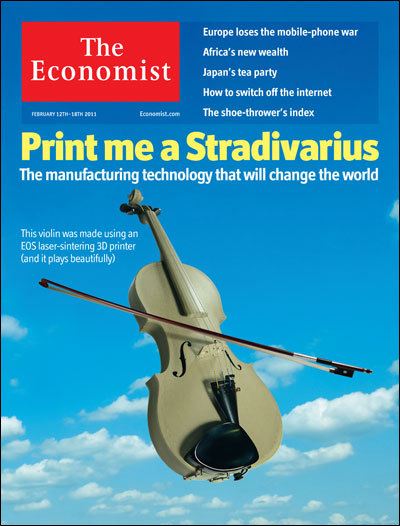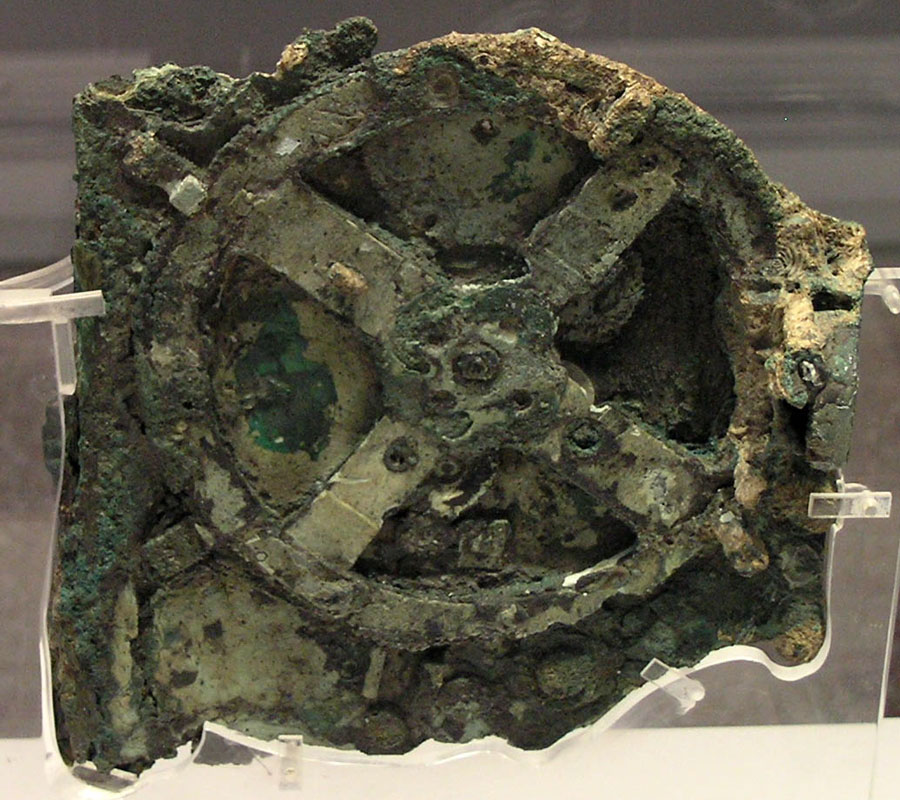
One of my few complaints against my favourite magazine The Economist is that they do not normally give much space to non-political, non-economic topics even though their treatment of such topics is always very interesting and thought provoking. So I was pleasantly surprised when the cover story in a recent issue was on a new technology – Print me a Stradivarius: The manufacturing technology that will change the world (The Economist, February 12th -18th 2011). It talks about a revolutionary new
technology called additive manufacturing. This technology uses 3D printers to produce real life objects (as per your design) by putting layers after layers of the basic material (hence the name additive). The cover carries picture of a violin made using a 3D printer, which the magazine certifies, plays beautifully. From a simple coffee mug to aircraft parts you can literally create a world of your own with the help of this technology. Economist predicts that if the Industrial era was about mass production then this technology of new generation cottage industry is likely to disrupt the entire socio-economic foundations of the present global economy. There is a long list of possible disruptions from assembly line manufacturing and competitiveness of Asian manufacturers to urban life and intellectual property regime – but one has to agree with the magazine’s conclusion that in the long run it is bound to expand not only the realm of industry but also of human imagination.
technology called additive manufacturing. This technology uses 3D printers to produce real life objects (as per your design) by putting layers after layers of the basic material (hence the name additive). The cover carries picture of a violin made using a 3D printer, which the magazine certifies, plays beautifully. From a simple coffee mug to aircraft parts you can literally create a world of your own with the help of this technology. Economist predicts that if the Industrial era was about mass production then this technology of new generation cottage industry is likely to disrupt the entire socio-economic foundations of the present global economy. There is a long list of possible disruptions from assembly line manufacturing and competitiveness of Asian manufacturers to urban life and intellectual property regime – but one has to agree with the magazine’s conclusion that in the long run it is bound to expand not only the realm of industry but also of human imagination.
How far you can expand your imagination while thinking about technologies in the ancient world? No, I am not talking about whether Pushpak raths were actually aero planes or such stuff. As far as our knowledge goes (and honestly that is not very far) the most amazing machine manufactured in the ancient world (of which we have definite material evidence) was almost like an analog computer (albeit for only a given subject).
First time when I heard about it I could not really expand my imagination to accept that such a thing was in fact manufactured in the second century before Christ. In 1900-01, sponge divers off Point Glyphadia on the Greek Island of Antikythera recovered certain articles from a shipwreck site. The ill-fated ship went under water sometime in the 1st or 2nd century BC. Among the recovered articles was a mechanical
device since known Antikythera mechanism. It took experts actually decades to fully understand how it worked – perhaps because they could not really expand their horizon of imagination and also because certain parts of the machine were lost. Now the device is displayed at National Archaeological Museum at Athens along with a full size reconstruction. Replicas of this amazing device could also be seen in a number of other prominent museums around the world, including at Computer History Museum at Mountain View, Calif. not far from the headquarters of Google.
device since known Antikythera mechanism. It took experts actually decades to fully understand how it worked – perhaps because they could not really expand their horizon of imagination and also because certain parts of the machine were lost. Now the device is displayed at National Archaeological Museum at Athens along with a full size reconstruction. Replicas of this amazing device could also be seen in a number of other prominent museums around the world, including at Computer History Museum at Mountain View, Calif. not far from the headquarters of Google.

The device is actually a multi-geared programmeable machine, which could predict exact astronomical positions at a given time. In terms of sheer mechanical complexity, the world did not see anything like it till at least 14th century, when mechanical clocks were manufactured for the first time in Europe. The device had over 30 gears (according to one researcher it actually had 72 gears!) and three dials- one in front and two at back. After a date was entered via a hand crank, the device used to give exact position of Sun, Moon and other planets including Mars and Venus on that date. Front dial had three hands to show the date and positions of Sun and Moon. Front dial also contained marks of the ancient Egyptian calendar (Sothic Year) and Greek Zodiac signs. Another outstanding feature of the device was that in all these there were adjusting mechanisms for Leap Year (in Sothic Calendar, till the invention of Julian calendar in 1st century AD no calendar had provision to adjust extra 0.24 days per year) and anomalies in orbits of Sun and Moon. It has now been proved that the actual calculation behind the machine was based on Babylonian astronomy and not on Greek astronomy. But the complexity of the device simply goes on to show the incredible depth of knowledge the creators had in mathematics and astronomy besides their amazing skills in mechanical engineering. The front dial also contains a parapegma, precursor to modern almanac. Two back dials show divisions of Metonic and Saros Cycles respectively – all these were somehow very important in prediction of exact date, timing and planetary positions. It is of course quite difficult for a non-specialist to understand but not so difficult to appreciate the enormous knowledge behind this rather small device. The full size model made by Derek de Solla Price shows how wonderfully it worked.

Reconstructed model of Antikythera mechanism by Derek de Solla Price
The fact that it was so brilliantly designed and then sort of miniaturized indicates that there was a tradition of such mechanical activity before this particular device was manufactured. Two important questions come to mind – who built this and how the tradition was lost? For the first, there are some speculative answers – one of the latest researchers says it was some way connected with the great scientist Archimedes. Others talk about an academy founded by Posidonius in the island of Rhodes, which was known for its expertise in astronomy and mechanical engineering in ancient Greece. I could not find any answer anywhere in the internet about the second question. There were suggestions that some of the skills behind this device might have survived in Byzantium and then in the Islamic world- but that is hardly a satisfactory explanation. It must be considered a matter of great regret that such advancement in technological knowledge achieved in the second century BC could not be sustained by mankind.
Antikythera Mechanism continues to amaze and puzzle us more than 100 years after it was rediscovered.Now there is a full-fledged project dedicated to this extra-ordinary machine-the Antikythera Reaserch Project is fittingly being carried out by a number of Greek Universities , University of Cardiff and computer giant Hewlett -Packard.

No comments:
Post a Comment